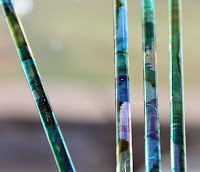Weaving has been hard, challenging and utterly frustrating, perhaps I was over ambitious. Using monofilament was not a good idea - though I am sure if all my stars were aligned, it would be easier :)
Most of the mono has been ditched, but I have retained some elements and am making some samples which I can live with - hooray !
Little fish
One way - not entirely successful - to create a second beam. At last, I have been able to put peg loom to some use.
I also discovered that super glue can be your friend when using monfilament, and that it is possible to come up with a knot which will work :)
 Double weave sample which I was really pleased with, however, the technical problems (warp) meant I had reconsider my position.
Double weave sample which I was really pleased with, however, the technical problems (warp) meant I had reconsider my position.
I decided to discard the warp, and start agin !

Over to the right -->
perspex rods, dyed with alcohol inks
 One of the earlier
One of the earlierimages from my sketchbook








